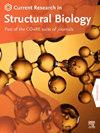Conformational changes induced by K949A mutation in the CRISPR-Cas12a complex drives an effective target-binding mechanism
IF 2.7
Q3 BIOCHEMISTRY & MOLECULAR BIOLOGY
引用次数: 0
Abstract
The CRISPR/Cas system is a potential tool for genome editing, yet it faces challenges due to off-target activity caused by mismatches at specific positions. However, Off-target activity can be minimized by optimal design of guide RNA (gRNA) but there remains a possibility of unintended cleavage, highlighting the role of the Cas nuclease in off-target recognition and binding the target site. This study focuses on comparing the conformational dynamics and stability of Wildtype, RR, RVR, RRm and RVRm variants of AsCas12a with gRNA-DNA bound complexes. It was found that the cross-correlation coefficient between His1167 of the NUC domain and Thr384 of the REC II domain significantly increased after the K949A mutation compared to other variants. The extensive spread of principal components also revealed flexibility in both Cas nuclease and gRNA-DNA hybrid of RVR variant and wildtype AsCas12a whereas the confined clusters in PCA plot suggests increased stability in both the variants after mutation. This study shows the role of K949A mutation in improving stability of PAM variants and predicted critical residues such as His1167, Thr384 and Ser959, in inducing stability in mutants of PAM variants.

CRISPR-Cas12a复合体中K949A突变引起的构象变化驱动了有效的靶标结合机制
CRISPR/Cas系统是一种潜在的基因组编辑工具,但由于特定位置的错配导致脱靶活动,它面临着挑战。然而,通过优化设计引导RNA (gRNA)可以将脱靶活性降至最低,但仍然存在意外切割的可能性,这突出了Cas核酸酶在脱靶识别和结合靶位点中的作用。本研究重点比较了AsCas12a的Wildtype、RR、RVR、RRm和RVRm变体与gRNA-DNA结合复合物的构象动力学和稳定性。结果发现,与其他变异相比,K949A突变后NUC结构域His1167与REC II结构域Thr384的交叉相关系数显著升高。主成分的广泛分布也揭示了RVR变体和野生型AsCas12a的Cas核酸酶和gRNA-DNA杂交的灵活性,而PCA图中有限的聚类表明突变后这两种变体的稳定性都增加了。本研究表明K949A突变在提高PAM变异体稳定性中的作用,并预测了关键残基如His1167、Thr384和Ser959在诱导PAM变异体稳定性中的作用。
本文章由计算机程序翻译,如有差异,请以英文原文为准。
求助全文
约1分钟内获得全文
求助全文

 求助内容:
求助内容: 应助结果提醒方式:
应助结果提醒方式:


